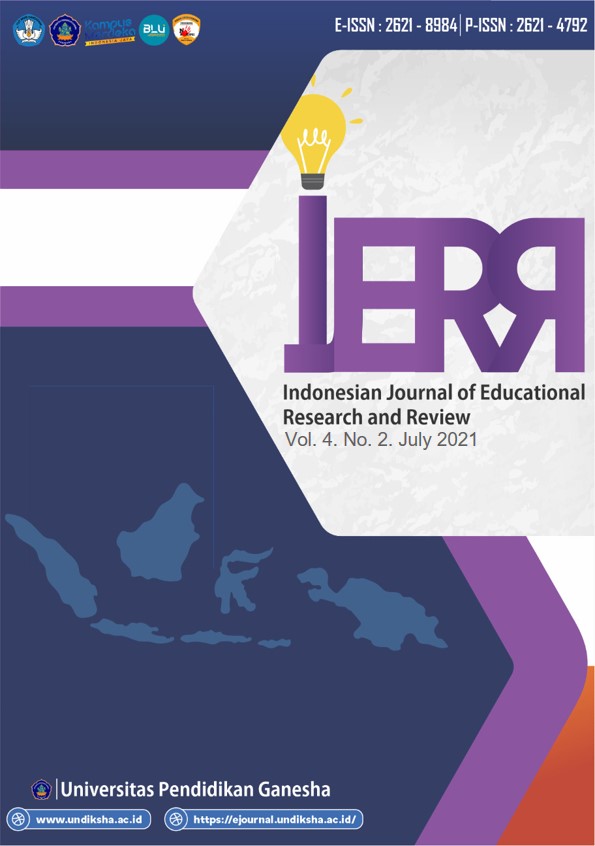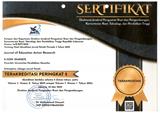Videos of Savi Oriented Learning Model Based on Sparcol Scribe in Class IV Students
DOI:
https://doi.org/10.23887/ijerr.v4i2.39927Keywords:
interactive learning videos, social studies subjects, saviAbstract
The low learning outcomes of fourth-grade elementary school students in social studies learning are caused by less attractive learning packaging. In addition, there is no application of interactive learning videos in the classroom. The research objective is to develop interactive learning videos. This type of research is the development of the ADDIE model. Data collection methods consist of interviews, observation, document recording, and distributing questionnaires. This study consisted of 3 experts, 6 small group students, and 3 individual test students. The instrument used to collect data is a questionnaire. The technique used to analyze the data is descriptive qualitative and quantitative analysis. The study results are the results of a review by content experts in the field of study with excellent qualifications (96.66%). The results of the review of media design experts with excellent qualifications (96%). The results of the review of media experts with excellent qualifications (90%). The results of individual trials with excellent qualifications (96.67%). The results of the small group trial with excellent qualifications (95.55%). It can be concluded that the use of interactive learning videos is feasible to be applied in learning. Learning videos can increase students' interest in social science.
References
Alnajdi, S. M. (2018). The Effectiveness of Designing and Using a Practical Interactive Lesson based on ADDIE Model to Enhance Students’ Learning Performances in University of Tabuk. Journal of Education and Learning, 7(6), 212. https://doi.org/10.5539/jel.v7n6p212
Andel, S. A., de Vreede, T., Spector, P. E., Padmanabhan, B., Singh, V. K., & Vreede, G. J. de. (2020). Do social features help in video-centric online learning platforms? A social presence perspective. Computers in Human Behavior, 113(April), 106505. https://doi.org/10.1016/j.chb.2020.106505
Asrial, Syahrial, Maison, M., Kurniawan, D. A., & Piyana, S. O. (2020). Ethnoconstructivism E-Module to Improve Perception, Interest, And Motivation of Students in Class V Elementary School. Jurnal Pendidikan Indonesia, 9(1), 30–41. https://doi.org/10.23887/jpi-undiksha.v9i1.19222
Bajrami, L., & Ismaili, M. (2016). The Role of Video Materials in EFL Classrooms. Procedia - Social and Behavioral Sciences, 232(April), 502–506. https://doi.org/10.1016/j.sbspro.2016.10.068
Bakırcı, H., Bilgin, A. K., & Simsek, A. (2011). The effects of simulation technique and worksheets on formal operational stage in science and technology lessons. Procedia - Social and Behavioral Sciences, 15. https://doi.org/10.1016/j.sbspro.2011.03.311
Bayles, J., Peterson, A. D., Pitts, S. J., Bian, H., Burkholder, S., Hegde, A. V., & Stage, V. C. (2021). Food-Based Science, Technology, Engineering, Arts, and Mathematics (STEAM) Learning Activities May Reduce Decline in Preschoolers’ Skin Carotenoid Status. Journal of Nutrition Education and Behavior, 53(4). https://doi.org/10.1016/j.jneb.2020.10.017
Bettencourt, C., Velho, J. L., & Almeida, P. A. (2011). Biology teachers’ perceptions about Science-Technology-Society (STS) education. Procedia - Social and Behavioral Sciences, 15. https://doi.org/10.1016/j.sbspro.2011.04.262
Budiarto, M. K., Joebagio, H., & Sudiyanto, S. (2020). Student’s View of Using Digital Learning Media in Classroom Activities: A Case of Public Senior High School in Cirebon, Indonesia. Jurnal Pendidikan Progresif, 10(1). https://doi.org/10.23960/jpp.v10.i1.202006
Bui, V. H., & Do Van Dung. (2019). Development of Vietnamese Vocational Education Teachers to adapt the Industrial Revolution 4.0. Asian Journal of Interdisciplinary Research, 2(4), 1–7. https://doi.org/10.34256/ajir1941
Cabaleiro-Cerviño, G., & Vera, C. (2020). The Impact of Educational Technologies in Higher Education. GIST – Education and Learning Research Journal, 20, 155–169. https://doi.org/10.26817/16925777.711
Chai, C. S., & Kong, S.-C. (2017). Professional learning for 21st century education. Journal of Computers in Education, 4(1), 1–4. https://doi.org/10.1007/s40692-016-0069-y
Chin, K.-Y., & Wang, C.-S. (2021). Effects of augmented reality technology in a mobile touring system on university students’ learning performance and interest. Australasian Journal of Educational Technology, 37(1). https://doi.org/10.14742/ajet.5841
Colasante, M., & Douglas, K. (2016). Prepare-participate-connect: Active learning with video annotation. Australasian Journal of Educational Technology, 32(4), 68–91. https://doi.org/10.14742/ajet.2123
Darmaji, Kurniawan, D. A., Astalini, Lumbantoruan, A., & Samosir, S. C. (2019). Mobile learning in higher education for the industrial revolution 4.0: Perception and response of physics practicum. In International Journal of Interactive Mobile Technologies (Vol. 13, Issue 9). https://doi.org/10.3991/ijim.v13i09.10948
Dhika, H., Destiawati, F., Sonny, M., & Surajiyo. (2019). Study of the use and application of the moodle e-learning platform in high school. Journal of Physics: Conference Series, 1175, 012219. https://doi.org/10.1088/1742-6596/1175/1/012219
Dhiu, K. D. (2017). Learning Motivation And Perception Of The Teachers’ Pedagogic Competence And Learning Achievement In Social Science Of Junior High School Students. Journal of Education Technology, 1(1), 6–12. https://doi.org/10.23887/jet.v1i1.10078
Gil-Flores, J., Rodríguez-Santero, J., & Torres-Gordillo, J. J. (2017). Factors that explain the use of ICT in secondary-education classrooms: The role of teacher characteristics and school infrastructure. Computers in Human Behavior, 68, 441–449. https://doi.org/10.1016/j.chb.2016.11.057
Gjems, L. (2013). Teaching in ECE: Promoting children’s language learning and cooperation on knowledge construction in everyday conversations in kindergarten. Teaching and Teacher Education, 29(1), 39–45. https://doi.org/10.1016/j.tate.2012.08.008
Gonźalez, Guzḿan, Dormido, & Berenguel. (2013). Development of Interactive Books for Control Education. IFAC Proceedings Volumes (IFAC-PapersOnline), 46(17). https://doi.org/10.3182/20130828-3-UK-2039.00043
Hamzah, I., & Mentari, S. (2017). Development of Accounting E-Module to Support the Scientific Approach of Students Grade X Vocational High School. Journal of Accounting and Business Education, 1(1), 78. https://doi.org/10.26675/jabe.v1i1.9751
Hanif, M. (2020). The development and effectiveness of motion graphic animation videos to improve primary school students’ sciences learning outcomes. International Journal of Instruction, 13(4), 247–266. https://doi.org/10.29333/iji.2020.13416a
Harjanta, A. T. J., & Herlambang, B. A. (2018). Rancang Bangun Game Edukasi Pemilihan Gubernur Jateng Berbasis Android Dengan Model ADDIE. Jurnal Transformatika, 16(1), 91–97. https://doi.org/10.26623/transformatika.v16i1.894
Hockings, C., Thomas, L., Ottaway, J., & Jones, R. (2018). Independent learning–what we do when you’re not there. Teaching in Higher Education, 23(2), 145–161. https://doi.org/10.1080/13562517.2017.1332031
Hosen, M., Ogbeibu, S., Giridharan, B., Cham, T.-H., Lim, W. M., & Paul, J. (2021). Individual motivation and social media influence on student knowledge sharing and learning performance: Evidence from an emerging economy. Computers & Education, 72. https://doi.org/10.1016/j.compedu.2021.104262
Hwang, G. J., Wang, S. Y., & Lai, C. L. (2020). Effects of a social regulation-based online learning framework on students’ learning achievements and behaviors in mathematics. Computers and Education, 160, 104031. https://doi.org/10.1016/j.compedu.2020.104031
Kamelia, K. (2019). Using Video as Media of Teaching in English Language Classroom: Expressing Congratulation and Hopes. Utamax : Journal of Ultimate Research and Trends in Education, 1(1), 34–38. https://doi.org/10.31849/utamax.v1i1.2742
Kartika, Y., Wahyuni, R., Sinaga, B., & Rajagukguk, J. (2019). Improving Math Creative Thinking Ability by using Math Adventure Educational Game as an Interactive Media. Journal of Physics: Conference Series, 1179(1), 1–6. https://doi.org/10.1088/1742-6596/1179/1/012078
Khamparia, A., & Pandey, B. (2017). Impact of interactive multimedia in E-learning technologies: Role of multimedia in E-learning. Enhancing Academic Research With Knowledge Management Principles, April, 199–227. https://doi.org/10.4018/978-1-5225-2489-2.ch007
Khan, T., Johnston, K., & Ophoff, J. (2019). The Impact of an Augmented Reality Application on Learning Motivation of Students. Advances in Human-Computer Interaction. https://doi.org/10.1155/2019/7208494
Kratz, F., Patzina, A., Kleinert, C., & Dietrich, H. (2019). Vocational education and employment: Explaining cohort variations in life course patterns. Social Inclusion, 7(3), 224–253. https://doi.org/10.17645/si.v7i3.2045
Lawrence, J. E., & Tar, U. A. (2018). Factors that influence teachers’ adoption and integration of ICT in teaching/learning process. Educational Media International, 55(1), 79–105. https://doi.org/10.1080/09523987.2018.1439712
Leatherman, J. L., & Cleveland, L. M. (2020). Student exam performance in flipped classroom sections is similar to that in active learning sections, and satisfaction with the flipped classroom hinges on attitudes toward learning from videos. Journal of Biological Education, 54(3), 328–344. https://doi.org/10.1080/00219266.2019.1575266
Li, C., Zhang, J., & Yao, J. (2021). Streamer action recognition in live video with spatial-temporal attention and deep dictionary learning. Neurocomputing, 453. https://doi.org/10.1016/j.neucom.2020.07.148
Liu, I.-F. (2020). The impact of extrinsic motivation, intrinsic motivation, and social self-efficacy on English competition participation intentions of pre-college learners: Differences between high school and vocational students in Taiwan. Learning and Motivation, 72. https://doi.org/10.1016/j.lmot.2020.101675
Mortazavi, S.-M. (2011). The relationship between time lapse between introducing lexical advance organizers and video viewing, and comprehension in a foreign language classroom. Procedia - Social and Behavioral Sciences, 15. https://doi.org/10.1016/j.sbspro.2011.04.047
Mpungose, C. B. (2021). Lecturers’ reflections on use of Zoom video conferencing technology for e-learning at a South African university in the context of coronavirus. African Identities. https://doi.org/10.1080/14725843.2021.1902268
Muhtadi, D., Wahyudin, Kartasasmita, B. G., & Prahmana, R. C. I. (2018). The Integration of technology in teaching mathematics. Journal of Physics: Conference Series, 943(1), 1–9. https://doi.org/10.1088/1742-6596/943/1/012020
Mutakinati, L., Anwari, I., & Yoshisuke, K. (2018). Analysis of students’ critical thinking skill of middle school through stem education project-based learning. Jurnal Pendidikan IPA Indonesia, 7(1), 54–65. https://doi.org/10.15294/jpii.v7i1.10495
Nonthamand, N. (2020). Guideline to develop an instructional design model using video conference in open learning. International Journal of Emerging Technologies in Learning, 15(3), 140–155. https://doi.org/10.3991/ijet.v15i03.10842
Nurdin, E., Ma’aruf, A., Amir, Z., Risnawati, R., Noviarni, N., & Azmi, M. P. (2019). Pemanfaatan video pembelajaran berbasis Geogebra untuk meningkatkan kemampuan pemahaman konsep matematis siswa SMK. Jurnal Riset Pendidikan Matematika, 6(1), 87–98. https://doi.org/10.21831/jrpm.v6i1.18421
Oktaviani, A., Anom, K., & Lesmini, B. (2020). Pengembangan Modul Kimia terintegrasi STEM (Science, Technology, Engineering and Mathematics) dan PBL (Problem-Based Learning). Journal of Educational Chemistry (JEC), 2(2), 64. https://doi.org/10.21580/jec.2020.2.2.6279
Pamungkas, A. S., Ihsanudin, I., Novaliyosi, N., & Yandari, I. A. V. (2018). Video Pembelajaran Berbasis Sparkol Videoscribe: Inovasi Pada Perkuliahan Sejarah Matematika. Prima: Jurnal Pendidikan Matematika, 2(2), 127. https://doi.org/10.31000/prima.v2i2.705
Pane, M. M., & Rina Patriana. (2016). The Significance of Environmental Contents in Character Education for Quality of Life. Procedia - Social and Behavioral Sciences, 222, 244–252. https://doi.org/10.1016/j.sbspro.2016.05.153
Priantini, D. A. (2020). The Development Of Teaching Video Media Based On Tri Kaya Parisudha In Educational Psychology Courses. Journal of Education Technology, 4(4). https://doi.org/10.23887/jet.v4i4.29608
Rabgay, T. (2018). The effect of using cooperative learning method on tenth grade students’ learning achievement and attitude towards biology. International Journal of Instruction, 11(2), 265–280. https://doi.org/10.12973/iji.2018.11218a
Rose, J. A., O’Meara, J. M., Gerhardt, T. C., & Williams, M. (2016). Gamification: using elements of video games to improve engagement in an undergraduate physics class. Physics Education, 51(5). https://doi.org/10.1088/0031-9120/51/5/055007
Saito, K., Dewaele, J.-M., Abe, M., & In’nami, Y. (2018). Motivation, Emotion, Learning Experience, and Second Language Comprehensibility Development in Classroom Settings: A Cross-Sectional and Longitudinal Study. Language Learning, 68(3), 709–743. https://doi.org/10.1111/lang.12297
Singh, B. (2019). Character education in the 21st century. Journal of Social Studies (JSS), 15(1), 1–12. https://doi.org/10.21831/jss.v15i1.25226
Sun, H., & Gao, Y. (2016). Impact of an active educational video game on children’s motivation, science knowledge, and physical activity. Journal of Sport and Health Science 5, 1(1), 239–245. https://doi.org/10.1016/j.jshs.2014.12.004
Suryanda, A., Sartono, N., & Sa’diyah, H. (2019). Developing smartphone-based laboratory manual as a learning media. Journal of Physics: Conference Series, 402. https://doi.org/10.1088/1742-6596/1402/7/077077
Syahroni, M. W., Dewi, N. R., & Kasmui. (2016). The Effect of Using Digimon (Science Digital Module) with Scientific Approach at the Visualization of Students’ Independence and Learning Results. Jurnal Pendidikan IPA Indonesia, 5(1), 116–122. https://doi.org/10.15294/jpii.v5i1.5800
Syauqi, K., Munadi, S., & Triyono, M. B. (2020). Students’ perceptions toward vocational education on online learning during the COVID-19 pandemic. International Journal of Evaluation and Research in Education (IJERE), 9(4), 881. https://doi.org/10.11591/ijere.v9i4.20766
Teng, (Mark) Feng. (2019). The effects of video caption types and advance organizers on incidental L2 collocation learning. Computers & Education, 142. https://doi.org/10.1016/j.compedu.2019.103655
Teng, M. F. (2019). The effects of video caption types and advance organizers on incidental L2 collocation learning. Computers & Education, 142. https://doi.org/10.1016/j.compedu.2019.103655
Tere, T., Bayu Seta, H., Nizar Hidayanto, A., & Abidin, Z. (2020). Variables Affecting E-Learning Services Quality in Indonesian Higher Education: Students’ Perspectives. Journal of Information Technology Education: Research, 19, 259–286. https://doi.org/10.28945/4489
Tseng, H., Yi, X., & Yeh, H. T. (2019). Learning-related soft skills among online business students in higher education: Grade level and managerial role differences in self-regulation, motivation, and social skill. Computers in Human Behavior, 95. https://doi.org/10.1016/j.chb.2018.11.035
Tseng, S. (2021). The influence of teacher annotations on student learning engagement and video watching behaviors. International Journal of Educational Technology in Higher Education, 18(1), 1–17. https://doi.org/10.1186/s41239-021-00242-5
TucksanunKlahan, & Yuenyong, C. (2012). An Analysis of Grade 12 Students’ Technological Capability in Learning About Electromagnetics Through Science Technology and Society Approach (STS Approach). Procedia - Social and Behavioral Sciences, 46. https://doi.org/10.1016/j.sbspro.2012.06.390
Tuma, F. (2021). The use of educational technology for interactive teaching in lectures. Annals of Medicine and Surgery 62, 231–235. https://doi.org/10.1016/j.amsu.2021.01.051
Van Alten, D. C. D., Phielix, C., Janssen, J., & Kester, L. (2019). Effects of flipping the classroom on learning outcomes and satisfaction: A meta-analysis. Educational Research Review, 28(June), 1–18. https://doi.org/10.1016/j.edurev.2019.05.003
Van Alten, D. C. D., Phielix, C., Janssen, J., & Kester, L. (2020). Self-regulated learning support in flipped learning videos enhances learning outcomes. Computers and Education, 158(August), 104000. https://doi.org/10.1016/j.compedu.2020.104000
Velan, G. M., Goergen, S. K., Grimm, J., & Shulruf, B. (2015). Impact of Interactive e-Learning Modules on Appropriateness of Imaging Referrals: A Multicenter, Randomized, Crossover Study. Journal of the American College of Radiology, 12(11). https://doi.org/10.1016/j.jacr.2015.06.026
Weiss, D., Rydland, H. T., Øversveen, E., Jensen, M. R., Solhaug, S., & Krokstad, S. (2018). Innovative technologies and social inequalities in health: A scoping review of the literature. PLoS ONE, 13(4), 1–20. https://doi.org/10.1371/journal.pone.0195447
Yavuz, M., Çorbacıoğlu, E., Başoğlu, A. N., Daim, T. U., & Shaygan, A. (2021). Augmented reality technology adoption: Case of a mobile application in Turkey. Technology in Society, 66. https://doi.org/10.1016/j.techsoc.2021.101598
Downloads
Published
Issue
Section
License
Authors who publish with the Indonesian Journal of Educational Research and Review (IJERR) agree to the following terms:
- Authors retain copyright and grant the journal the right of first publication with the work simultaneously licensed under a Creative Commons Attribution License (CC BY-SA 4.0) that allows others to share the work with an acknowledgment of the work's authorship and initial publication in this journal.
- Authors are able to enter into separate, additional contractual arrangements for the non-exclusive distribution of the journal's published version of the work (e.g., post it to an institutional repository or publish it in a book), with an acknowledgment of its initial publication in this journal.
- Authors are permitted and encouraged to post their work online (e.g., in institutional repositories or on their website) prior to and during the submission process, as it can lead to productive exchanges, as well as earlier and greater citation of published work. (See The Effect of Open Access)












